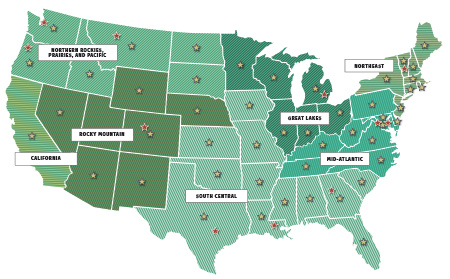Both wildlife and people depend on forests. Southeastern forests support more than 158 mammals, 504 birds and 178 amphibians. Ecosystems range from cypress trees in the swamps, pines and hardwoods across the region, to spruce and firs in higher elevations.
Longleaf pines can live for 300-400 years. These forests also contribute to a healthy environment by providing clean air and water sources, creating buffers from wildfire, and mitigating damage from hurricanes. Forests also provide oxygen, food, clean drinking water, shelter, a place to rest or hunt.
Twenty-nine species on the Federal threatened or endangered lists are found in these forests, however these pine forests are one of the most endangered landscapes in North America. Restoring longleaf forests could help a wide range of species including:
The National Wildlife Federation’s Southeast Forestry Program is dedicated to projects that protect and restore forests and wildlife habitats throughout the region, and longleaf pine restoration remains a keystone to our program. Our goal is to restore 20,000 acres by 2025, contributing to the 8 million goal set by America’s Longleaf Restoration Initiative (ALRI).
We have been fortunate to work alongside many other organizations including ALRI, which is guided by the Longleaf Partnership Council, and our affiliates to develop and implement strategies to bring back this iconic forest to the south through several initiatives.
Private landowners are important to the success of restoring longleaf pine in the South. Currently, more than 85% of southern forests are held by private landowners. Working in coordination with our affiliates, we work with private landowners to replant longleaf species in existing forested areas, and encouraging the conversion of retired agricultural lands back to longleaf forests.
Fire plays a critical role in the entire longleaf pine ecosystem, which isn’t surprising since longleaf forests evolved in a region known for its frequent lightning. Fire was discovered to be the essential element in providing calcium for improved breeding in red-cockaded woodpeckers. Fire also results in suitable nest sites for ground-nesting birds such as Bachmann’s sparrow and open spaces essential for gopher tortoises to forage and dig burrows. Low-intensity controlled fires can clear away brush for these species and keep the forest open by suppressing the growth of hardwood species such as oak and tulip that could stifle longleaf seedlings.
Without periodic fires, the flora and fauna adapted to longleaf pine ecosystems cannot flourish, so conducting prescribed burns is integral to forest management for longleaf pines. Through educational workshops and other outreach activities, the National Wildlife Federation is educating landowners on prescribed burns for long leaf. To learn more on outreach with landowners on the effectiveness and implementation procedures to conduct a prescribed burn, visit our program SandHill Prescribed Burn Association.
Balancing economic, ecological and social values is crucial to restoration goals. The harvest of freshly-fallen pine needles is a growing industry in the southeastern United States. With an increasing demand, pine straw can be a valuable source of income for forest landowners. However, pine needles also serve an important role in the forest from protecting soil and cycling nutrients. We’re working with landowners to establish a balance (pdf) between harvesting of pine straw and preserving the ecological needs of wildlife.
Weather extremes such as temperature increases, shifts in precipitation, more severe storms, and other climate changes are stressing natural ecosystems and forcing communities to rethink how we manage our forests, water supply, and other natural resources.
Fortunately, longleaf pine ecosystems are naturally resilient to climate extremes in the Southeast. Longleaf pine grows under very dry and very wet conditions, is tolerant of and even dependent on frequent fire, is more resilient to wind and severe storms, and is more resistant to beetle infestations likely to be exacerbated by warmer and drier conditions. Because other pine species in the Southeast may be more susceptible to the changes, longleaf pine’s high tolerance makes it a desirable choice for forest management options.
Due to the commitment of our partners and other organizations, longleaf pine is making a comeback. Acreage has extended to nearly 4.7 million acres, which is a first known increase since the 1990s.
A new storymap connects the dots between extreme weather and climate change and illustrates the harm these disasters inflict on communities and wildlife.
Learn MoreTake the Clean Earth Challenge and help make the planet a happier, healthier place.
Learn MoreA groundbreaking bipartisan bill aims to address the looming wildlife crisis before it's too late, while creating sorely needed jobs.
Read MoreMore than one-third of U.S. fish and wildlife species are at risk of extinction in the coming decades. We're on the ground in seven regions across the country, collaborating with 52 state and territory affiliates to reverse the crisis and ensure wildlife thrive.
